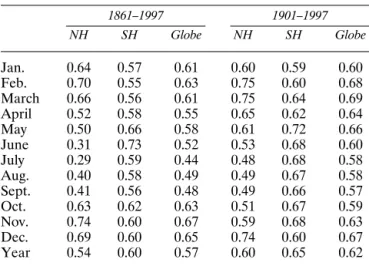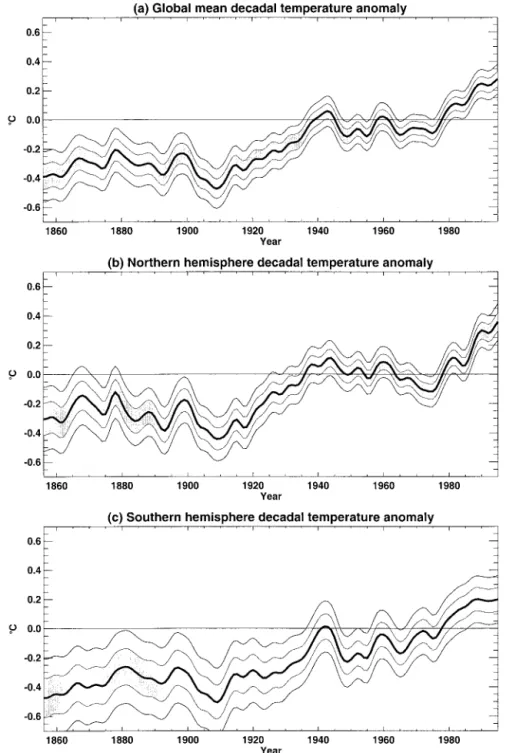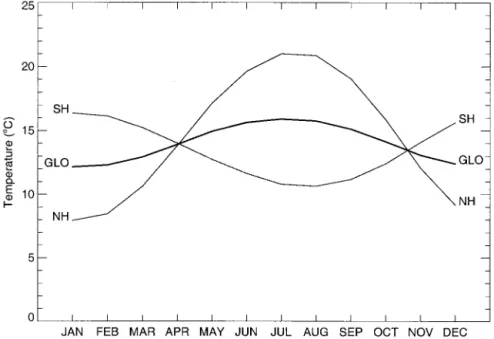THE PAST 150 YEARS
P. D. Jones,
1M. New,
1D. E. Parker,
2S. Martin,
3and I. G. Rigor
4Abstract. We review the surface air temperature record of the past 150 years, considering the homogene- ity of the basic data and the standard errors of estima- tion of the average hemispheric and global estimates.
We present global fields of surface temperature change over the two 20-year periods of greatest warming this century, 1925–1944 and 1978–1997. Over these periods, global temperatures rose by 0.37 8 and 0.32 8 C, respec- tively. The twentieth-century warming has been accom- panied by a decrease in those areas of the world affected by exceptionally cool temperatures and to a lesser extent by increases in areas affected by exceptionally warm temperatures. In recent decades there have been much greater increases in night minimum temperatures than in day maximum temperatures, so that over 1950–1993 the diurnal temperature range has decreased by 0.08 8 C per decade. We discuss the recent divergence of surface
and satellite temperature measurements of the lower troposphere and consider the last 150 years in the con- text of the last millennium. We then provide a globally complete absolute surface air temperature climatology on a 1 8 3 1 8 grid. This is primarily based on data for 1961–1990. Extensive interpolation had to be under- taken over both polar regions and in a few other regions where basic data are scarce, but we believe the climatol- ogy is the most consistent and reliable of absolute sur- face air temperature conditions over the world. The climatology indicates that the annual average surface temperature of the world is 14.0 8 C (14.6 8 C in the North- ern Hemisphere (NH) and 13.4 8 C for the Southern Hemisphere). The annual cycle of global mean temper- atures follows that of the land-dominated NH, with a maximum in July of 15.9 8 C and a minimum in January of 12.2 8 C.
1. INTRODUCTION
The surface air temperature database has been exten- sively reviewed on several earlier occasions, most nota- bly by Wigley et al. [1985, 1986] and Ellsaesser et al. [1986]
and by the Intergovernmental Panel on Climate Change (IPCC) [Folland et al., 1990, 1992; Nicholls et al., 1996].
This work extends these by using slight improvements to the basic surface database and updates the records to the end of 1998. Most importantly, it also provides a com- prehensive analysis of surface air temperatures in abso- lute rather than anomaly units, by the development of a 1 8 by 1 8 grid box climatology for all land, ocean, and sea ice areas based on the 1961–1990 period.
The structure of this review is as follows. Section 2 discusses the quality of the raw land and marine tem- perature data, addressing the long-term homogeneity of the basic data and considering those subtle changes that might influence the data, such as urbanization of land
areas and gradual changes in observing practices over the ocean. Section 3 reviews several methods that have been used to aggregate the basic data to a regular grid, the basic aim of which is to reduce the effects of spatial and temporal variations in the spatial density of avail- able data. Future improvements to the network are discussed.
Before consideration of what the data tell us about the post-1850 instrumental era, section 4 assesses the accuracy of the estimates of hemispheric and global temperature anomalies, particularly during the nine- teenth century, when coverage was poorer. Section 5 then analyzes the surface temperature record. It com- pares patterns of warming over the 1978–1997 period with those of the earlier 1925–1944 period, which expe- rienced a comparable rate of warming. It also considers trends in the areas affected by extreme temperatures, recent trends in Arctic temperatures and in maximum and minimum temperatures, the recent divergence of surface temperature trends and satellite retrievals of lower tropospheric temperature trends, and the last 150 years in a longer near-millennial context.
The discussion in section 5 is limited to what the surface record tells us about past temperature changes.
Extensive discussion of the reasons for the changes (both variations in atmospheric circulation and past external
1
Climatic Research Unit, University of East Anglia, Nor- wich, England.
2
Hadley Centre, Meteorological Office, Bracknell, England.
3
School of Oceanography, University of Washington, Seattle.
4
Applied Physics Laboratory, University of Washington, Seattle.
Copyright 1999 by the American Geophysical Union. Reviews of Geophysics, 37, 2 / May 1999 pages 173–199
8755-1209/99/1999RG900002$15.00 Paper number 1999RG900002
●


